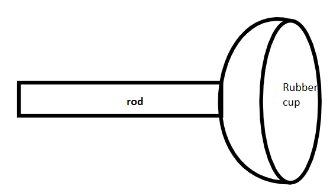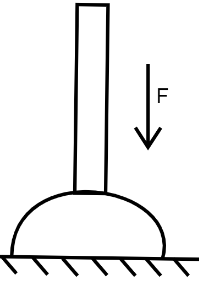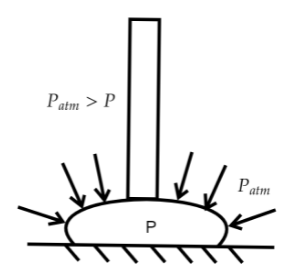
What is a rubber sucker? How does it work?
Answer
411.9k+ views
Hint:In order to answer the above question, we will first understand what we mean by a rubber sucker. We will be looking up at the construction of a rubber sucker. We will also understand how a rubber sucker works and how atmospheric pressure plays an important role in its working.
Complete answer:
First of all, we will learn about a rubber sucker or we call it a suction cup. Suction cups are used in a variety of applications, from hanging products to smooth surfaces in our homes and vehicles, as well as more technologically challenging applications such as lifting delicate and heavy objects safely and in a regulated manner using suction cups and vacuum pumps.
Suction cups are increasingly being used in robotic applications, such as climbing robots and window cleaners. Suction cups based on the biomimetic design of octopus vulgaris, remora (sucker fish), and limpets are currently being researched, and could lead to suction cups that adhere to surfaces with varying degrees of surface roughness.The diagram of a rubber sucker is as given below:

As we can see from the figure that a rubber sucker or a suction cup consists of a rod for support and a cup made of rubber attached to it. Now, we will look at the working of a rubber sucker or a suction cup. As we all know that when a suction cup is pressed to a surface, it sticks to the surface and does not come off easily. We can say that this effect is mainly due to pressure.

As seen in the figure, the suction cut is pushed down onto a surface. The cup is attached to the surface and some amount of air is trapped in it. When a suction cup is pressed down to a surface with a certain amount of force, the cup experiences a pressure $(P)$. Now, we know that the air which is trapped inside the cup is at atmospheric pressure $({P_{atm}})$.
If the pressure experienced by the cup is more than the atmospheric pressure of air that is trapped inside the cup, then the air tries and escapes through the cavity between the cup and the surface. As the air that is trapped inside the cup is gradually decreasing, the pressure inside the cup is also decreased. This pressure is decreased more and more until the pressure becomes negligible inside the suction cup.

As a result, the pressure inside the cup becomes very less than the atmospheric pressure outside the cup. Therefore, ${P_{atm}} > P$. Finally, if the force applied to the suction cup is taken out, then the pressure applied on the cup is removed and hence,

The only forces acting on the cup are due to the pressure outside the cup, i.e., the atmospheric pressure, and the pressure inside the cup which is left after the evacuation of the air. Now, we already know that the atmospheric pressure outside the cup is greater than the pressure inside the cup and hence there will be a force acting on the cup by the atmospheric pressure that helps the cup stay in place stuck to the surface until and unless the air from outside find a way or a cavity to get inside the cup and neutralise the pressure.But as there is a good amount of pressure difference, the air from outside will not get a cavity to fill in and as a result the suction cup will stay stuck on the surface until it is pulled from outside.
Note:It is very important to note that the air travels spontaneously from a region of higher pressure to a region of lower pressure. The wind on earth is an example of this. A rubber sucker works best for smooth and polished surfaces as there is no cavity for the air to fill in the suction cup and as a result the suction cup will have a good hold on the surface. Whereas, if the surface is too rough, there will be a large amount of cavities for the air to fill the suction cup and hence, the suction cup will not have a good grip on the surface and will come out easily.
Complete answer:
First of all, we will learn about a rubber sucker or we call it a suction cup. Suction cups are used in a variety of applications, from hanging products to smooth surfaces in our homes and vehicles, as well as more technologically challenging applications such as lifting delicate and heavy objects safely and in a regulated manner using suction cups and vacuum pumps.
Suction cups are increasingly being used in robotic applications, such as climbing robots and window cleaners. Suction cups based on the biomimetic design of octopus vulgaris, remora (sucker fish), and limpets are currently being researched, and could lead to suction cups that adhere to surfaces with varying degrees of surface roughness.The diagram of a rubber sucker is as given below:

As we can see from the figure that a rubber sucker or a suction cup consists of a rod for support and a cup made of rubber attached to it. Now, we will look at the working of a rubber sucker or a suction cup. As we all know that when a suction cup is pressed to a surface, it sticks to the surface and does not come off easily. We can say that this effect is mainly due to pressure.

As seen in the figure, the suction cut is pushed down onto a surface. The cup is attached to the surface and some amount of air is trapped in it. When a suction cup is pressed down to a surface with a certain amount of force, the cup experiences a pressure $(P)$. Now, we know that the air which is trapped inside the cup is at atmospheric pressure $({P_{atm}})$.
If the pressure experienced by the cup is more than the atmospheric pressure of air that is trapped inside the cup, then the air tries and escapes through the cavity between the cup and the surface. As the air that is trapped inside the cup is gradually decreasing, the pressure inside the cup is also decreased. This pressure is decreased more and more until the pressure becomes negligible inside the suction cup.

As a result, the pressure inside the cup becomes very less than the atmospheric pressure outside the cup. Therefore, ${P_{atm}} > P$. Finally, if the force applied to the suction cup is taken out, then the pressure applied on the cup is removed and hence,

The only forces acting on the cup are due to the pressure outside the cup, i.e., the atmospheric pressure, and the pressure inside the cup which is left after the evacuation of the air. Now, we already know that the atmospheric pressure outside the cup is greater than the pressure inside the cup and hence there will be a force acting on the cup by the atmospheric pressure that helps the cup stay in place stuck to the surface until and unless the air from outside find a way or a cavity to get inside the cup and neutralise the pressure.But as there is a good amount of pressure difference, the air from outside will not get a cavity to fill in and as a result the suction cup will stay stuck on the surface until it is pulled from outside.
Note:It is very important to note that the air travels spontaneously from a region of higher pressure to a region of lower pressure. The wind on earth is an example of this. A rubber sucker works best for smooth and polished surfaces as there is no cavity for the air to fill in the suction cup and as a result the suction cup will have a good hold on the surface. Whereas, if the surface is too rough, there will be a large amount of cavities for the air to fill the suction cup and hence, the suction cup will not have a good grip on the surface and will come out easily.
Recently Updated Pages
Master Class 9 General Knowledge: Engaging Questions & Answers for Success

Master Class 9 English: Engaging Questions & Answers for Success

Master Class 9 Science: Engaging Questions & Answers for Success

Master Class 9 Social Science: Engaging Questions & Answers for Success

Master Class 9 Maths: Engaging Questions & Answers for Success

Class 9 Question and Answer - Your Ultimate Solutions Guide

Trending doubts
Fill the blanks with the suitable prepositions 1 The class 9 english CBSE

What is the color of ferrous sulphate crystals? How does this color change after heating? Name the products formed on strongly heating ferrous sulphate crystals. What type of chemical reaction occurs in this type of change.

How do you graph the function fx 4x class 9 maths CBSE

Difference Between Plant Cell and Animal Cell

The largest oil field of India is A Digboi B Bombay class 9 social science CBSE

What is pollution? How many types of pollution? Define it




